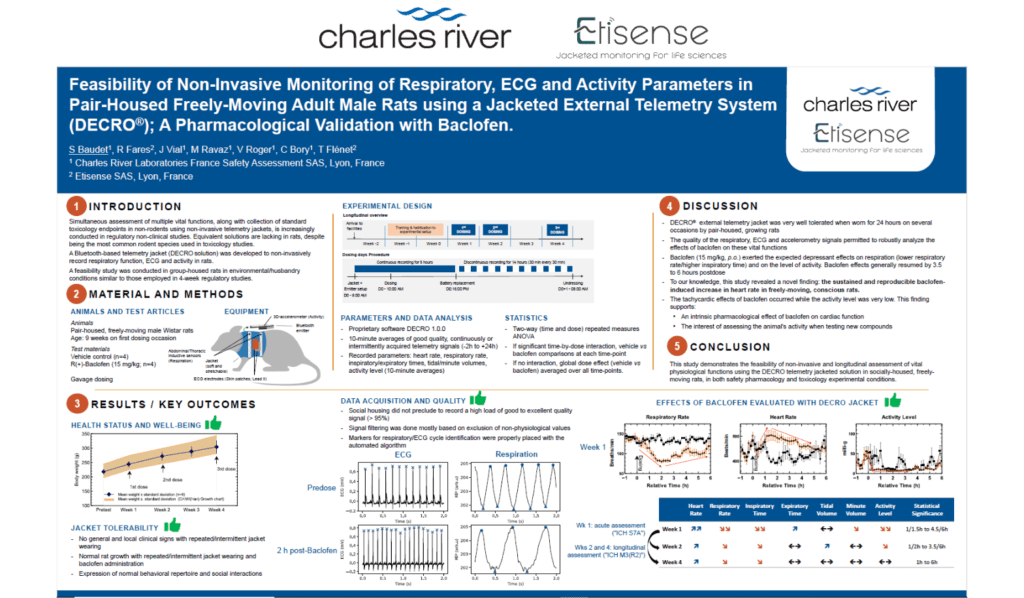S Baudet¹, R Fares², J Vial¹, M Ravaz¹, V Roger¹, C Bory¹, T Flénet²
¹ Charles River Laboratories France Safety Assessment SAS, Lyon, France
² Etisense SAS, Lyon, France
Safety Pharmacology Society Annual Meeting, Virtual, 2021, 06/10
Abstract
Simultaneous assessment of multiple vital functions, along with collection of standard toxicology endpoints in non-rodents using non-invasive telemetry jackets, is increasingly conducted in regulatory non-clinical studies. Equivalent solutions are lacking in rats, despite being the most common rodent species used in toxicology studies. A Bluetooth-based telemetry jacket (DECRO®) was developed to non-invasively record respiratory function, ECG and activity in rats. A feasibility study was conducted in two groups of four male rats, pair-housed in environmental/husbandry conditions similar to those employed in 4-week regulatory studies. Respiration and ECG were measured with thoracic/abdominal inductance bands and patch electrodes, respectively, and activity was monitored with a miniaturized, battery-powered accelerometer telemetry device fitted in the jacket. To evaluate pharmacological effects of a reference compound, baclofen (20 mg/kg; respiratory depressant) or vehicle was orally administered once in Weeks 1, 2 and 4. Signals were continuously recorded from 2h predose to 6h postdose, then intermittently recorded for 0.5h, every hour, until 22h postdose. Data were analyzed using proprietary software yielding ECG-derived heart rate, activity level, respiratory rate, inspiratory/expiratory times and tidal/minute volumes. After rejecting signals impaired by movement artifacts, more than 95% (ECG) and 60% (respiratory) of the data were analyzable. Jackets were well tolerated (five fittings/removals per animal), with minimal damage (when present). On each dosing occasion, baclofen-induced effects (% change versus time-matched vehicle) were: 1) lower respiratory rate, between -40% and -9% at 1.75/2.5h and lasting up to 3.5/5h; 2) higher inspiratory time, between 75% and 100% at 0.5/1.5h and lasting up to 2/6h; 3) higher heart rate, up to 26% at 1.75/2.75h and lasting up to 3.5/5h; and 4), and minimal activity between 0.5/1h and lasting up to 2/6h. Tidal volume increased slightly but variability was noticeable and precluded showing consistent time patterns. With repeated administrations, baclofen-induced changes became less pronounced and shorter lasting on respiratory function and activity, whilst heart rate effects remained stable over hours and weeks. This study demonstrates the feasibility of repeated, non-invasive and longitudinal assessment of vital physiological functions using the DECRO® telemetry jacketed solution in socially-housed rats.

